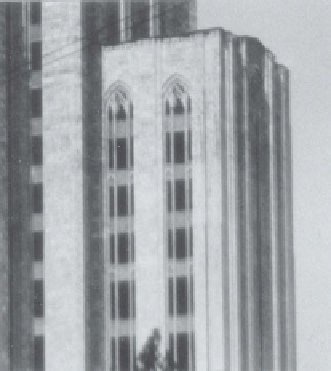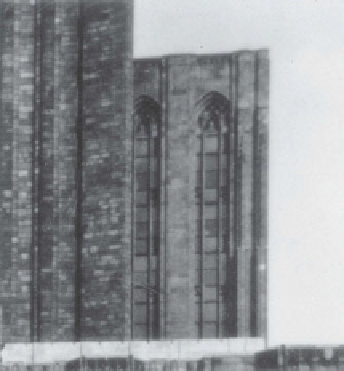Geoscience Reference
In-Depth Information
(a) 1930
(b) 1934
Figure 10.8.
Soiling of the limestone exterior of the Cathedral of Learning at the University of Pittsburgh
between (a) 1930 and (b) 1934 (Davidson et al., 2000). The building was constructed between 1929 and 1937.
Sulfate and soot from coal smoke caused erosion and darkening of the building after only 4 years.
Photo courtesy University Archives, University of Pittsburgh.
10.6.4. Sodium Chloride
Some acidic soils near nonpolluted coastal areas are
naturally neutralized by cations originating from sea
spray (e.g., Na
+
,Ca
2
+
,Mg
2
+
,K
+
)that have deposited
onto soils over the millennia. The pH of natural seawa-
ter ranges from 7.8 to 8.3, and that of uncontaminated
large sea spray drops is similar, indicating that little
H
+
exists in such drops. The deposition of sea spray
drops to coastal soils, and the subsequent desiccation
of these drops, produces common salt [NaCl(s)]. When
sulfate-containing water enters NaCl(s)-containing
soils, NaCl(s) dissolves and dissociates, H
+
combines
with the chloride ion [Cl
−
]toformHCl(aq), which
evaporates to the gas phase. The net process is
The net result is the formation of a clear-to-white gyp-
sum crust over the marble or limestone. Bombardment
by rain over time removes some of the brittle gyp-
sum crust. Because the crust now contains part of the
statue or building material (the calcium), its removal
creates tiny crevices, or pits, causing erosion (David-
son et al., 2000). Because the gypsum crust and the
crevices roughen the surface of a statue or building,
other pollutants, such as soot, more readily bond to
the surface, darkening it, as illustrated in Figure 10.8.
It shows photographs of the
Cathedral of Learning
at the University of Pittsburgh, taken in 1930, soon
after the start of its construction, and in 1934. Dur-
ing a 4-year period, sulfate from coal smoke emitted by
steel mills and locomotives (Section 4.1.6.3) roughened
the limestone exterior of the building, and soot from
the same smoke bonded with the roughened exterior,
darkening it.
Gypsum forms not only on buildings, but also in
soils and aerosol particles. When rainwater containing
the sulfate ion falls on soil containing calcite, the cal-
cite dissociates by Reaction 10.17. When the soil dries,
the calcium ion reacts with the sulfate ion by Reac-
tion 10.18, producing gypsum. The same process occurs
when soil dust particles containing calcite collide with
acidified raindrops. Deposition of rain containing sul-
furic acid over soils containing calcite and deposition
of particles already containing gypsum have, over time,
produced worldwide
deposits of gypsum soil
.
H
+
Hydrogen
ion
Na
+
Sodium
ion
NaCl(s)
Sodium
chloride
+
+
HCl(g)
Hydrochloric
acid
(10.19)
which reduces H
+
and the acidity of soil water and
increases pH.
10.6.5. Ammonia
Ammonia gas
[NH
3
(g)] is considered an anthropogenic
pollutant, but it also neutralizes raindrop and soil water
acidity. Figure 5.14 gave worldwide emission sources of
ammonia gas. Once in the air, ammonia gas dissolves in



Search WWH ::

Custom Search